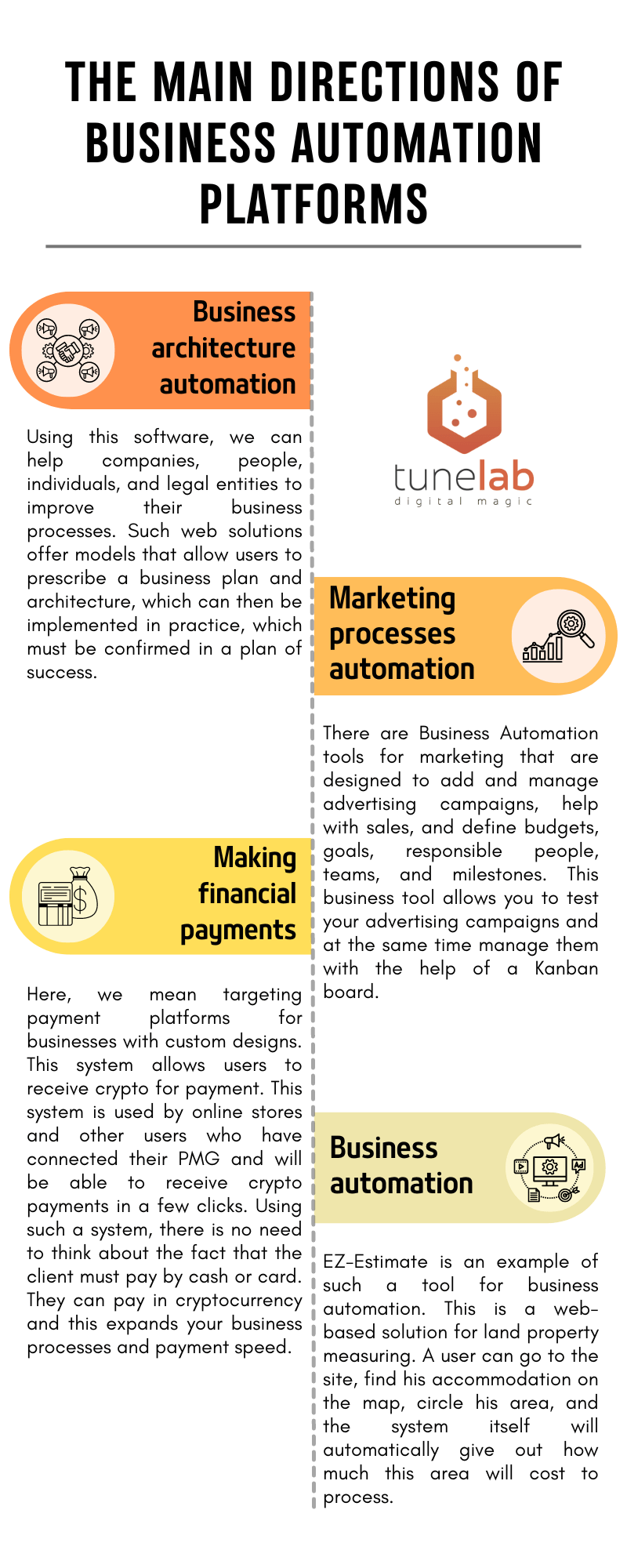Business process automation tools have become a must-have for companies who want to improve their inner business processes and customer service. To put it simply, the Business Automation Platform is a tool that helps companies optimize their processes, improve resource management, and improve customer service.
These tools can automate various types of tasks – from monotonous routines to more complex bureaucratic processes. By using BAP, businesses can reduce work time and the number of human errors. These are just a small percentage of the benefits that business automation platforms can provide, which we will talk more about in our new post. We will also share our own experience in developing BAP, and the main directions in which these tools are most often used.
Understanding Business Automation Platforms

Business automation tools are software that automate and optimize processes within the company. There are two types of business automation tools: commercial and internal. Commercial tools are created to automate business processes, which, first of all, are aimed at the implementation of commercial activities (sale of goods, fulfillment of orders provision of services, etc.).
Custom personal solutions for internal use are developed to automate non-commercial processes, such as optimizing the inventory system and organizing solutions for insurance cases related to road accidents, for example.
How Business Automation Platforms Drive Efficiency and Growth
Let’s go into more detail about the types of benefits mentioned above. The commercial benefit is aimed at maintaining and ensuring the ease of use of the platform by the user. For example, among such automation tools, there is a calculator that can calculate the size of the foot for shoes and convert the size from American to European.
An example of internal non-commercial optimization can be the same inventory system. For example, before the optimization, the company could keep inventory, but only on the desktop and there was no way to transfer data, except by exporting a file to another computer. Therefore, a web solution is being developed, that can be accessed quickly at any time from any gadget, after logging in and seeing the remaining balances, as well as making new ones.
Exploring the Main Directions of Business Automation Platforms
Depending on the type of software and the direction of automation, the goals of business automation can be as follows:
- Business architecture automation. Using this software, we can help companies, people, individuals, and legal entities to improve their business processes. Such web solutions offer models that allow users to prescribe a business plan and architecture, which can then be implemented in practice, which must be confirmed in a plan of success.
- Marketing processes automation. There are Business Automation tools for marketing that are designed to add and manage advertising campaigns, help with sales, and define budgets, goals, responsible people, teams, and milestones. This business tool allows you to test your advertising campaigns and at the same time manage them with the help of a Kanban board.
- Business automation. EZ-Estimate is an example of such a tool for business automation. This is a web-based solution for land property measuring. A user can go to the site, find his accommodation on the map, circle his area, and the system itself will automatically give out how much this area will cost to process.
- Making financial payments. Here, we mean targeting payment platforms for businesses with custom designs. This system allows users to receive crypto for payment. This system is used by online stores and other users who have connected their PMG and will be able to receive crypto payments in a few clicks. Using such a system, there is no need to think about the fact that the client must pay by cash or card. They can pay in cryptocurrency and this expands your business processes and payment speed.
What You Need to Know About Business Automation Platforms Development
How is the development of automation bodies going and what is our approach? In the beginning, a client comes to us with their idea and description. First of all, requirements are collected. If the user’s requirements are incomplete, i.e. there is no specification, or project documentation (where the entire flow, user case, functional set, and business logic are fully described), then the company must write the documentation. Documentation is necessary for the success of writing the project and in the success of its development in principle, to reach the end without encountering pitfalls, to understand the budget, and also to manage the budget correctly.
After that, there are already such projects as it is desirable to have a custom design because a unique idea must be unique from the outside. And if you use some kind of template then the uniqueness is lost a bit and for the MVP version we can find similar templates on the web that can be used with minimal customization. Well, and then, of course, there is development and testing according to Scrum, Agile methodology, and the principle of three servers: local, staging, and production.
The development of a solution for business optimization can be as different as possible, but its goals and ideas are to simplify, help, and solve. We are developing a platform to automate bureaucratic processes. Our client currently has a lot of paper bureaucracy, all documents are stored in paper form, and all this must be digitized. Therefore, we are developing a web solution where the user at any time downloads the necessary document for insurance from a phone or computer and sends it. The client then receives and sends the written document, creates an invoice, and sends insurance.
The Essential Technologies Behind Business Automation Platforms
To develop tools for business automation, we use Vue.JS and React for the front end and PHP and Laravel for the back end. Depending on the needs, we can also use MySQL, NoSQL, and PostgreSQL. Also, in addition to this, we can do all this on Node.JS, Nuxt.JS, and Next. JS. We use third-party services, such as AWS, Digital Ocean, and others, to create databases that can be used to back up data. Backups can be made once a day, once a week, or once a month. It all depends on the amount of this data and how much the client is willing to pay for this data to be saved.
Essential Security Standards for Business Automation Platforms
In creating platforms for business automation, we need to comply with security standards, both IGO for the US and GDPR and HIPAA Compliance for the European Union. They establish standards for the storage of user data, such as their names, bank accounts, medical history, etc. Also, these standards provide that the user can delete their data irrevocably at any time and they must be erased in the database.
There are also coding standards to protect data. To better secure your project and its data, it is better not to use open-source solutions that can be hacked, because this code is freely available and anyone who knows the code can try to hack it. It is much more difficult to break a custom solution because here you need to know the project from the inside and get access to the code.
The Business Automation Platform has become an irreplaceable tool for achieving efficiency and competitiveness for a considerable number of companies. Depending on the goals that the company wants to achieve, there are commercial and non-commercial tools for automation. The first tools are aimed at optimizing processes aimed at direct business activities (selling goods and customer service). Non-commercial organizations automate internal processes aimed directly at the company’s work (transferring paper bureaucracy to the digital space, for example). Using automation tools, businesses significantly change the approach to their activities, automating repetitive tasks and focusing on strategic initiatives.
The examples of BAP and our experience in developing them mentioned above demonstrate how different industries from marketing to fintech are increasing their productivity. Whether it’s improving business architecture or automating marketing campaigns, BAP provides powerful tools to achieve these goals and help today’s businesses stay afloat.
Keywords: automation tools, digital transformation, rpa automation, tools and automation, automation and tooling, platform as as service, inventory management software, software inventory management software, management software, business management software, inventory management, use cases, software as a service software, software to service, business software, sap software, business to business software, customer experience, software to manage employees, app softwares, software and application, robotic process automation, rpa robotic process automation, rpa process automation


